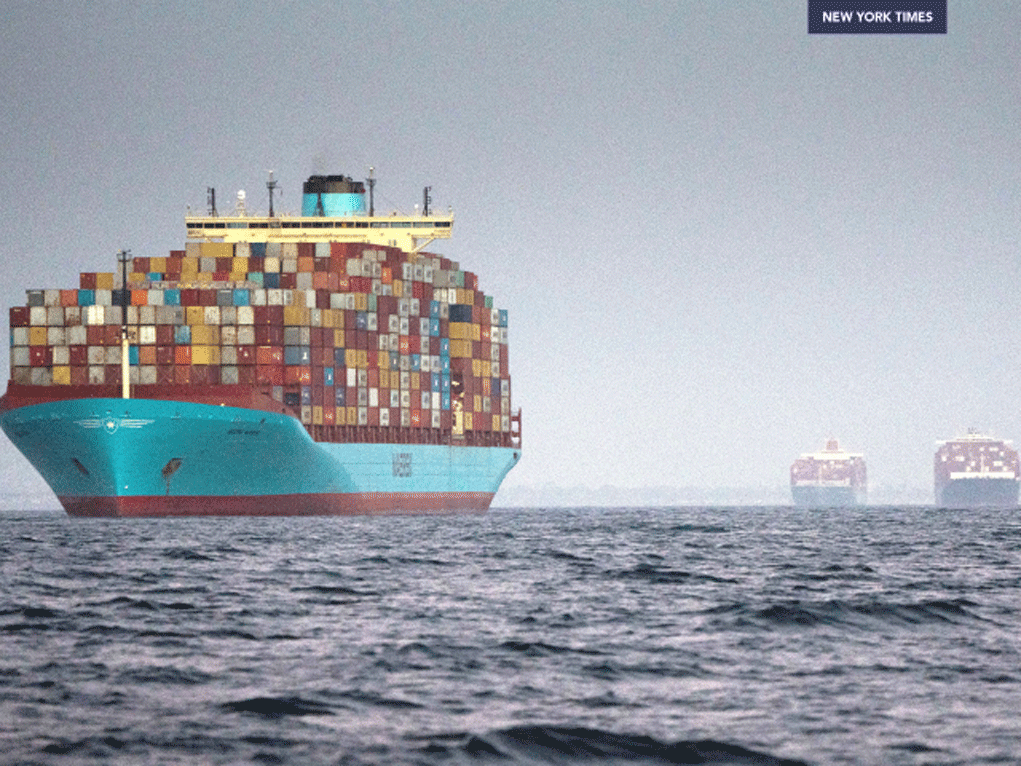There is a growing consensus of opinion that the recent spike in inflation, driven by growing shortages, persistent supply chain problems, and a lack of available workers to fill an estimated 10 million job openings, present a unique set of challenge to Joe Biden’s presidency.
That consensus is supported by the latest numbers on the performance of the US economy during the third quarter of 2021. They indicate sharply slowing growth, a drag on the manufacturing sector due to commodity shortages and supply chain issues, and falling consumer confidence. While President Biden is not responsible for creating all these problems, his liberal policies in response to them have made many of them worse instead of better.
Inflation, for example, is generally the result of too much money in the hands of consumers bidding up the price of goods and services which are in short supply.
Since the start of the pandemic last year, the federal government has injected $5.8 trillion of spending power into the US economy, representing a 40% boost in consumer purchasing power. Nevertheless, the third quarter show a sharp drop in the rate of growth of the Gross Domestic Product (GDP), the standard measure of the country’s economic activity, to only 2%.
At the same time, the boost in consumer spending power, combined with months of pent up demand during the pandemic lockdowns, has fueled the highest inflation rate in 40 years. Chronic shortages of a wide variety of key commodities have developed due in part to the inability of newly reopened businesses to ramp up their production of goods and services fast enough to keep pace with consumer demand. Shortages have also been aggravated by disruptions to transportation and production, especially in countries around the world that have suffered new waves of Covid infections due to the spread of the Delta variant.
A VICIOUS CYCLE OF INFLATION
This set of circumstances has created a vicious cycle in which consumers are now effectively bidding against one another for the reduced amounts of goods and services that are available. This enables businesses to raise prices both to cover their sharply increased costs for raw materials, transportation, energy, and labor, and to make up for the losses they suffered during their own lockdowns.
Unfortunately, many of these supply chain issues and shortages cannot be remedied quickly. For example, because there are not enough workers available to unload ships arriving at major US ports, nor enough space at those ports to store the freight containers they carry, scores of ships are typically left waiting at sea for weeks for a berth to become available at their destination port.
Cumulatively, these delays reduce the worldwide capacity to move freight quickly and efficiently by sea, driving up shipping costs. Meanwhile, the companies which ordered the raw materials or finished products whose delivery has been delayed have to cut back their own production schedules and disappoint their customers, because they can’t manufacture and deliver their goods on time.
Eventually, that means that retail stores and supermarkets across the country will be stuck with empty shelves and unhappy customers during the upcoming end-of-year annual shopping season. Even though many consumers might have the money they need due to the generous Biden Covid relief payments, they will have a difficult time finding the goods they want to buy with it — especially at the prices they are used to paying.
SHIPS AND CARGO PILING UP IN PORTS
It gets worse. In response to the widely reported backups of ships waiting offshore at major ports such as Los Angeles and Long Beach in California, the Biden administration recently announced an agreement with port managers and dockworker unions to keep them open and operating overnight, to help clear up the backlog. But the strategy hasn’t worked.
According to the most recent count, there are 150,000 shipping containers still clogging the docks at the two southern California ports, and there were 74 container ships anchored in San Pedro Bay, waiting for a berth at one of the ports to become available.
Reporters visiting those ports overnight find them still mostly idle, because many truckers are unwilling to make pickups during those hours. Their reasons are simple. First of all, there is a nationwide shortage of licensed big rig truck drivers, whose services are now in demand, so they don’t have to work late hours to make higher wages. Second, if they do make late night freight pickups from the ports, the truck drivers are likely to find the warehouses where those goods are to be delivered to be closed until the next normal business day starts, because they, too, can’t find enough workers willing to work unloading arriving freight overnight.
THE SUPPLY CHAIN DOMINO EFFECT
Each delay in deliveries leads to another supply chain problem and increased costs. These problems tend to cascade like falling dominoes, affecting a wide variety of consumer goods which have never before been subject to such shortages.
The Biden administration attempted to deal with the driver shortage by appealing to schools that train commercial truck drivers to add new classes and speed up the training. But schools responded that they could not comply, because many of the state agencies that test and license truck drivers had shut down due to the pandemic or severely restricted their hours of operation, reducing the number of students who could obtain licenses.
The big trucking companies also report that even if they could find enough licensed drivers, they don’t have enough trucks available to substantially increase their deliveries. When they try to buy new trucks, they are often told that they are just not available due to the global computer chip shortage which has forced automakers to make sharp cuts in their vehicle production plans.
THE “JUST-IN-TIME” DELIVERY SYSTEM IS NO LONGER WORKING
The chip shortages, in turn, are the result of the “just-in-time” inventory procedures that the American auto industry adopted in response to competition from Japan in the 1980s. American car manufacturers used to order large quantities of the parts and raw materials they needed to avoid costly interruptions of work on assembly lines due to shortages. However, Japanese auto producers had worked out a system with their suppliers in which they could order parts and raw materials in much smaller quantities, and still be certain that they would be delivered on schedule, eliminating the need for the auto makers to keep months’ worth of costly inventories on hand at all time.
The system also enabled Japanese automakers to keep a closer eye on the quality of the components they were using, making it possible for them to make better cars than Detroit and sell them to American customers at lower prices.
American carmakers were forced to adopt the Japanese “just-in-time” system if they wanted to keep their shares of the domestic new car market, and it has now become a standard practice for them. They had gotten used to ordering all the components they need to build their new cars, including a large number of computer chips from international manufacturers mostly located in South Korea and Taiwan. When the pandemic hit last year, the Detroit carmakers canceled most of their usual orders, based on the initially accurate assumption that new car sales would fall.
WHERE ALL THE COMPUTER CHIPS WENT
Another immediate effect of the pandemic were the school lockdowns around the world, which created a surge in demand for laptops and other internet-enabled devices that students needed to access Zoom sessions replacing in-classroom instruction. All the excess chips that the automakers no longer thought they needed, and many more, were being used by computer makers to satisfy these new demands from the educational market. This created instant shortages affecting other manufacturers using the same chips to make cellphones and “smart” home appliances and TV sets.
The auto industry learned it had made a mistake when the demand for new cars recovered far sooner than expected. They were being bought by many people who were afraid, due to Covid, to keep using mass transit to get to and from work. Other new car buyers included those who were telecommuting and decided to abandon their expensive center city apartments for more spacious and affordable homes in the suburbs, where a car was a necessity.
When the carmakers tried to reinstate their canceled chip orders, they were told there were none immediately available, and that they would have to wait for months — and in some cases, years — until new chip factories or assembly lines could go into operation to catch up with the increased demand.
As a result, new car production has slowed to a crawl, and there are hundreds of thousands of otherwise fully assembled cars waiting for the computer chips they need before they can be shipped to car dealerships for delivery to their buyers. Carmakers have prioritized how they use the small number of computer chips they do have available, reserving them for their most expensive and profitable models, which are the only ones still generally available for retail purchasers.
The automobile industry is not the only electronics-intensive industry that is suffering. Both Samsung and Apple, the world’s largest cellphone manufacturers, have been forced to delay the introduction of their newest models due to shortages of the advanced computer chips they need. Apple CEO Tim Cook told investors last week that the chip shortages and Covid-related manufacturing disruptions were responsible for a $6 billion shortfall in the expected sales of iPads, iPhones, and Mac computers so far this year.
In response, the Biden administration has been urging the US semi-conductor industry to start building new chip factories in the US, but it will take years and many billions of dollars of investment before any of those state-of-the-art factories are up and running.
A DIFFERENT KIND OF RECESSION
These are just a few of the many problems that resulted from last year’s lockdowns. They created a steep artificial recession, justifying the initial rounds of emergency government stimulus handouts. The money was needed to help millions of workers whose jobs had disappeared overnight until the lockdowns could be lifted, enabling the economy to begin returning to normal.
The standard economic response to cyclical American recessions since the end of World War II has been to expand the money supply and reduce interest rates to boost consumer demand. But that only works when there is enough unused capacity in the American economy to increase output sufficiently to meet that increased demand, providing jobs for the unemployed workers and an incentive for business to invest in new plants and equipment to further boost their productivity and profits.
That was not the case in the recovery from the pandemic-driven recession. In this case, as the Wall Street Journal noted, “shortage of demand hasn’t been the problem. The issue is the supply side of the economy, which has been experiencing a shortage of labor, resources, and components to produce goods. [Liberal] Keynesian [economists] typically ignore, or even deride, supply problems because they don’t fit their academic models. The White House and Federal Reserve are dominated by economists who focus on demand, which is one reason they overestimated growth this year but underestimated inflation.
“This bias has led to policy mistakes that have added to the supply woes. The flood of government money, untied to any work requirement, has reduced the incentive for millions to return to the labor force. Businesses are paying more but can’t find enough willing workers. . .
“Nothing in the [Biden] administration’s Build Back Better plan is pro-growth. The welfare and entitlement spending will deter work, while the tax increases will reduce incentives [for investment]. . .
“None of this suggests a recession, given the inevitable recovery from the pandemic lockdowns. But the tragedy is that the expansion would be so much faster, and so much better for so many more people, if the Biden administration had done nothing at all.”
TROUBLE REVERSING GEARS FAST ENOUGH
In response to the sudden lockdowns soon after Covid began spreading last year, businesses were forced to shut down their “non-essential” factories and shops, laying off their workers and doing everything they could to survive by conserving their cash until the lockdowns was over.
However, when the lockdowns were lifted, the dormant businesses could not reverse gears fast enough to meet the sudden spurt in demand. Millions of workers who had gotten used to living comfortably at home during the pandemic on expanded federal unemployment benefits were not eager to return to their former workplace jobs, which paid them less than the benefits they would have to give up.
By the beginning of this year, Republicans were arguing that the emergency pandemic benefits had done their job, and it was time to start scaling them back so that the natural balance of supply and demand in the economy could be restored. But the Democrat progressives who came to power with President Biden saw the situation differently. They realized they had been given a once-in-a-lifetime opportunity to make unprecedented government expenditures on new and vastly expanded social welfare programs under the cover of the need to sustain the economic recovery from the pandemic.
Based on advice from Treasury Secretary Janet Yellen, Biden urged his fellow Democrats then newly in control of both the House and Senate to “go big” in the scale of the next round of stimulus spending, ignoring Republican warnings that much of it was no longer necessary — and potentially counterproductive.
DEMOCRATS TOOK ADVANTAGE OF THE BIG SPENDING OPPORTUNITY
Biden and the Democrats went forward with a huge $1.9 trillion stimulus package, without any Republican support, that was stuffed with spending items which had long languished on the liberal legislative wish list. Many were unrelated to the economy’s specific post-pandemic needs, and some, including the extension of overgenerous federal unemployment benefits, actually slowed the pace of pandemic recovery.
Other Biden administration policies also aggravated the problems created by the pandemic. Chief among them was its encouragement of school districts across the country to heed the demands of teachers’ union leaders to prolong the largely unnecessary shutdowns of their public schools, at the expense of the educational progress of tens of millions of children and the prevention of their parents from going back to work.
THE HIDDEN COSTS OF CLEAN ENERGY
Liberal anti-climate change policies, some of which had been at work for years before Biden took office, had also sapped the American economy of its natural capacity to bounce back quickly from temporary problems.
President Biden was not responsible for the extreme cold snap last winter which caused an unexpected power shortage in Texas, or the extended drought in the Western states which forced hydroelectric plants throughout the region to cut back on their power generation, or the hurricane this summer which caused extensive damage to oil wells, pipelines, and refineries along the Gulf Coast. But the ongoing liberal war against the domestic fossil fuel industry which Biden eagerly adopted as a centerpiece of his administration’s policy agenda made it difficult for that industry and utilities across the country to recover from those setbacks due to rare natural occurrences.
Utilities had become too reliant on replacement renewable sources of power not nearly as reliable as the fossil-fuel and nuclear power plants that the liberals had forced shut. Biden’s executive orders halting the construction on of the Keystone oil pipeline that would bring oil from Canada, and his ban on new drilling on federal lands, had the effect that he had desired by reducing domestic energy production and making America once again dependent on imported foreign oil.
The predictable result was spot shortages and a sharp increase in the price of gas at the pump, hitting the pocketbook of every working-class family in America that is dependent on its car, as well as predictions of soaring home heating bills this coming winter, driving up the rate of inflation.
DOUBLING DOWN ON THE WRONG POLICIES
Yet the Biden administration reacted by doubling down on many of its policies which were slowing the economic recovery and increasing the inflationary pressures. For example, it has been pushing for congressional passage of two bills which initially called for an additional $5.7 trillion of federal spending over the next decade, including half a trillion-dollars to accelerate its efforts to shut down the use of fossil fuel in this country.
Most recently, Biden issued executive orders to impose federal vaccine mandates not only on federal employees and contractors, but also on virtually every health care provider in the country, as well as an estimated 100 million employees of mid-size and larger private companies across the country under OSHA’s jurisdiction. This mandate will have the effect of worsening the current shortage of workers by forcing millions of people unwilling to be vaccinated to give up their jobs, or be fired. This could turn into a major public health problem, especially if there is another wave of Covid infections. Hospitals and other medical facilities around the country have been suffering from staff shortages and worker burnout since the pandemic started. They may not be able to continue normal operations if they now are forced to fire even a small percentage of their staff because they refuse to be vaccinated.
There is also a crisis in the airline industry due to stress on overworked employees after the airlines cut back sharply on staff during the height of the pandemic, when most of their flights were canceled. In recent months, they have not been able to rehire furloughed staff members fast enough to keep up with the rapid increase in airline passenger traffic.
Spirit Airlines, Southwest Airlines, and American Airlines have been forced to make thousands of flight cancelations because they do not have enough available crew members for all their scheduled flights, especially if they have to deal with bad weather delays at hub airports. Most of the cancelations occur near the end of each month, when pilots who have been urged to make extra flights start reaching the maximum number of hours they are allowed to fly under FAA safety regulations.
THE “BUCK” STILL STOPS ON THE PRESIDENT’S DESK
The airline cancelations are an example of a pandemic-related economic problem that is not Biden’s fault, but which adds to the general impression that the efficient US economy we have gotten used to is breaking down. Even though Biden was not responsible in these cases for the breakdowns in service, voters still tend to blame the president first, because he is supposed to be the person in charge.
The famous sign on President Harry Truman’s White House desk was correct in declaring that, “The buck stops here.”
It is also clear that the unintended effects of Biden’s wrongheaded liberal policies have made some of these serious but temporary problems much worse than they would otherwise have been. The Biden administration has also now admitted that some of the worst supply chain problems, such as the shipping backups, will last well into next year and beyond.
PORTRAIT OF A RECOVERY IN TROUBLE
As a result, despite the gigantic cash infusion from Biden’s stimulus package, the economic recovery is now slowing at an alarming pace. The latest estimate of GDP growth was only 2%, its slowest pace since the end of the 2020 recession, due largely to a deceleration in consumer spending, due both to shortages of available products due to increasing supply chain issues, and growing consumer pessimism about the direction of the economy.
A recent survey by Institute for Supply Management confirms that the growth of national manufacturing activity is also slowing, due in large part to shortages of 26 different commodities.
For example, the survey said that computer and electronic products makers reported “extreme delays” and that “getting anything from China is near impossible.” Such delays in deliveries, labor shortages, and increases in commodity prices will inevitably translate in the months ahead to higher retail prices for all kinds of manufactured goods.
The ISM survey also reported a worrying drop in new factory orders in October, probably as a result of the growing realization by manufacturers that their current supply chain problems are not likely to improve much in the near term.
Consumer confidence in the health of the economy is also falling, according to a recent Gallup survey, while a Fox News poll found that 87% of consumers said they were “extremely” or “very” concerned about rising prices. That agrees with the assessment by Jan Hatzius, a Goldman Sachs economist, who expects inflation to remain well above 3% through next year — more than 50% higher than the Federal Reserve’s target of 2%.
BIDEN EXPLAINS HIS CONFUSING FOSSIL FUEL POLICY
These are some of the daunting economic challenges that President Biden must confront. But it was reassuring to hear him acknowledge to reporters at the G20 summit in Rome on Sunday that he was aware that he appeared to be inconsistent in fighting the domestic fossil fuel industry while at the same time pleading with OPEC oil producers and Russia to increase their output to slow the recent increases in gas prices at the pump.
“On the surface, it seems like an irony,” Biden began, “but the truth of the matter is. . . that the idea we’re going to be able to move to renewable energy overnight was just not rational.”
Biden stated that the transition from fossil fuels to zero carbon emission sources of energy would take years, and that it was meanwhile essential that people be able to continue to afford to drive their gasoline-powered cars and heat their homes with fossil fuels.
DEFENDING A REALISTIC COMPROMISE
The president emphasized that middle class Americans “have to get to their work. They have to get in an automobile, turn on the key, get their kids to school, the school buses have to run.” He said the idea “that there’s an alternative to walk away from being able to get in your automobile is just not realistic; it’s not going to happen.”
Biden’s statement was immediately attacked by several climate change activists who insist that to prevent a global warming disaster, all fossil fuel usage must be halted as soon as possible to keep alive the possibility of halting the emission of greenhouse gases, before permanent damage is done by average global temperatures increases exceeding the 1.5-degree Celsius limit defined by the 2015 Paris Agreement.
In August, when the latest report by the UN’s IPCC climate change working group was published, UN Secretary-General Antonio Guterres tweeted, “The evidence is irrefutable: greenhouse gas emissions are choking our planet & placing billions of people in danger. . . Global heating is affecting every region on Earth, with many of the changes becoming irreversible. . . We must act decisively now to avert a climate catastrophe.”
But President Biden’s position was defended by Jason Bordoff of the Columbia University Climate School, who conceded that while the timing of his request for increased foreign oil production “may be awkward, doing so reflects economic reality. . . It makes perfect sense for the Biden administration to simultaneously seek to make sure there’s adequate and affordable energy for households today and at the same time take the most aggressive measures in US history to spur vehicle electrification and move beyond oil in the future.”








